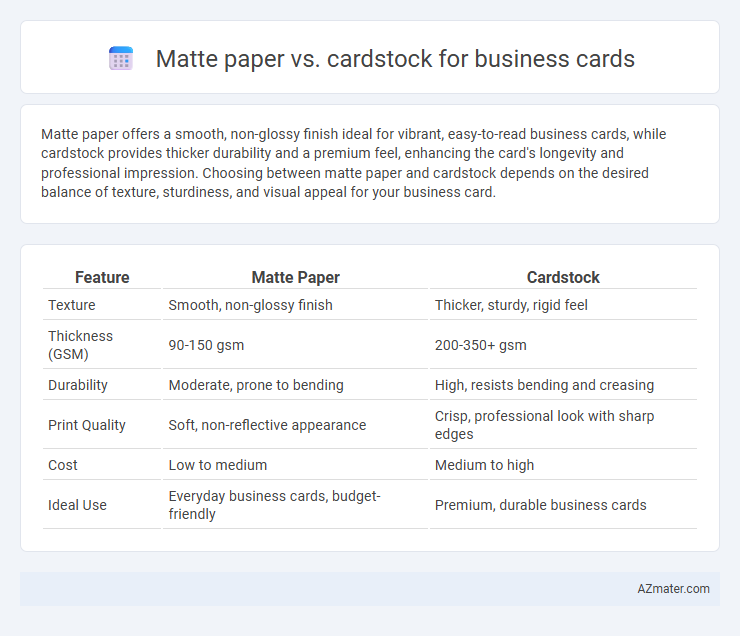Matte paper offers a smooth, non-glossy finish ideal for vibrant, easy-to-read business cards, while cardstock provides thicker durability and a premium feel, enhancing the card's longevity and professional impression. Choosing between matte paper and cardstock depends on the desired balance of texture, sturdiness, and visual appeal for your business card.
Table of Comparison
| Feature | Matte Paper | Cardstock |
|---|---|---|
| Texture | Smooth, non-glossy finish | Thicker, sturdy, rigid feel |
| Thickness (GSM) | 90-150 gsm | 200-350+ gsm |
| Durability | Moderate, prone to bending | High, resists bending and creasing |
| Print Quality | Soft, non-reflective appearance | Crisp, professional look with sharp edges |
| Cost | Low to medium | Medium to high |
| Ideal Use | Everyday business cards, budget-friendly | Premium, durable business cards |
Understanding Matte Paper and Cardstock
Matte paper offers a smooth, non-glossy finish that reduces glare and enhances readability, making it ideal for business cards with detailed text or subtle designs. Cardstock, characterized by its thick and sturdy composition, provides durability and a premium feel that withstands wear and tear better than regular paper. Understanding the balance between matte paper's texture and cardstock's weight helps in selecting the perfect business card material that aligns with brand identity and usage needs.
Key Differences Between Matte Paper and Cardstock
Matte paper offers a smooth, non-reflective surface ideal for business cards requiring muted, professional aesthetics, while cardstock is generally thicker, providing enhanced durability and a sturdy feel. Matte paper's lightweight nature allows for crisp printing of fine details, whereas cardstock's robust weight ensures longevity and resistance to wear and tear. Choosing between the two depends on the desired tactile impression and durability for business cards, balancing visual appeal with physical resilience.
Durability: Matte Paper vs Cardstock
Cardstock offers superior durability compared to matte paper due to its thicker and sturdier composition, making it ideal for business cards that endure frequent handling. Matte paper, while providing a smooth, non-glossy finish, is generally thinner and more prone to bending or wear over time. Choosing cardstock ensures long-lasting cards that maintain their structural integrity and professional appearance under regular use.
Print Quality Comparison
Matte paper offers a smooth, non-reflective finish that enhances readability and minimizes glare, making text and logos appear crisp and clear on business cards. Cardstock provides a thicker, more durable base that maintains sharp print detail and vibrant colors, ensuring longevity and a professional look. Businesses seeking a premium tactile feel often prefer cardstock, while those prioritizing subtle elegance opt for matte paper due to its refined surface texture.
Texture and Feel in Hand
Matte paper offers a smooth, velvety texture that feels soft and refined in hand, enhancing the professional look of business cards with a non-reflective surface. Cardstock, typically thicker and stiffer, provides a solid and durable feel that conveys sturdiness and quality, making it ideal for cards meant to leave a lasting tactile impression. The choice between matte paper and cardstock depends on whether a softer touch or a firmer, more substantial hand feel is desired.
Suitability for Business Branding
Matte paper offers a smooth, non-reflective finish that conveys a professional and understated elegance, making it ideal for brands aiming for a sophisticated and subtle impression. Cardstock provides a thicker, more durable option that enhances perceived quality and durability, suitable for brands emphasizing strength and reliability. Choosing between matte paper and cardstock depends on the desired brand image, with matte paper supporting a refined look and cardstock reinforcing a robust, premium feel.
Cost Analysis: Matte Paper vs Cardstock
Matte paper for business cards typically costs less per sheet compared to cardstock, making it a budget-friendly option for small print runs or promotional events. Cardstock, although more expensive, offers greater durability and a premium feel that can enhance brand perception and justify higher pricing. Evaluating the cost per unit alongside the desired quality and target audience helps businesses make an informed decision between matte paper and cardstock.
Customization Options Available
Matte paper offers a smooth, non-glossy finish that enhances readability and is ideal for detailed custom prints with subtle colors or texturized designs. Cardstock provides a thicker, more durable base that supports embossed logos, foil stamping, and die-cut shapes, allowing for premium customization that makes business cards stand out. Choosing between matte paper and cardstock depends on the desired tactile experience and the range of advanced customization options for branding impact.
Eco-Friendliness and Sustainability
Matte paper business cards often use thinner fibers, making them more biodegradable and easier to recycle compared to heavier cardstock, which typically requires more resources to produce and process. Cardstock, while sturdier and more durable, may involve higher carbon emissions during manufacturing and often uses more chemical coatings, reducing its eco-friendliness. Choosing recycled or FSC-certified matte paper further enhances sustainability by reducing deforestation and minimizing waste, aligning with green business practices.
Choosing the Best Material for Your Business Cards
Matte paper offers a smooth, non-reflective finish that enhances readability and presents a sophisticated, understated look, ideal for professional business cards. Cardstock is thicker and more durable, providing a sturdy feel that communicates quality and longevity, making it a preferable choice for business cards that need to withstand frequent handling. Selecting between matte paper and cardstock depends on balancing desired aesthetics with durability requirements to ensure your business card effectively represents your brand identity.

Infographic: Matte paper vs Cardstock for Business card
 azmater.com
azmater.com